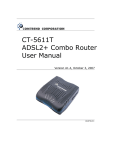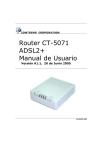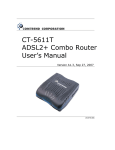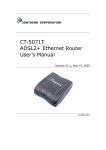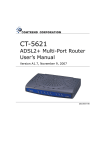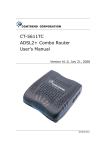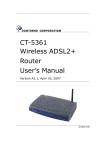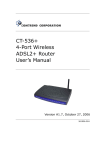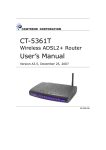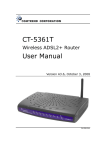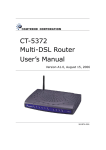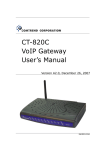Download Comtrend Corporation CT-5071 User`s manual
Transcript
CT-5071 ADSL2+ Router User’s Manual Version A1.2, February 10, 2006 261063-004 Preface This manual provides information to network administrators. It covers the installation, operation and applications of the ADSL router. The reader reading this manual is presumed to have a basic understanding of telecommunications. For product update, new product release, manual revision, software upgrade, technical support, etc., visit Comtrend Corporation at http://www.comtrend.com This document is subject to change without notice. Warning Before servicing or disassembling this equipment, always disconnect all power and telephone lines from the device. Use an appropriate power supply and a UL Listed telephone line cord. Specification of the power supply is clearly stated in Appendix B Specifications. Copyright Copyright© 2006 Comtrend Corporation. All rights reserved. The information and messages contained herein are proprietary to Comtrend Corporation. No part of this document may be translated, transcribed, reproduced, in any form, or by any means without prior written permission by Comtrend Corporation. Technical support When you find the product out of service, or that it doesn’t work properly, please contact technical support engineer for immediate servicing or email to [email protected] 1 Table of Contents CHAPTER 1 1.1 1.2 1.3 FEATURES ............................................................................................................ 4 APPLICATION ....................................................................................................... 5 FRONT PANEL LED INDICATORS ......................................................................... 6 CHAPTER 2 2.1 INTRODUCTION................................................................................. 4 INSTALLATION.................................................................................. 7 HARDWARE INSTALLATION.................................................................................. 7 CHAPTER 3 LOGIN VIA THE WEB BROWSER ................................... 8 3.1 3.2 IP ADDRESS ......................................................................................................... 8 LOGIN PROCEDURE .............................................................................................. 9 3.2.1 Default Settings........................................................................................ 10 CHAPTER 4 4.1 4.2 QUICK SETUP ......................................................................... 11 AUTO QUICK SETUP ........................................................................................... 12 MANUAL QUICK SETUP...................................................................................... 12 CHAPTER 5 DEVICE INFO............................................................................ 28 5.1 5.2 WAN ................................................................................................................. 29 STATISTICS ........................................................................................................ 30 5.2.1 LAN Statistics ........................................................................................... 30 5.2.2 WAN Statistics .......................................................................................... 32 5.2.3 ATM statistics ........................................................................................... 33 5.2.4 ADSL Statistics ......................................................................................... 35 5.2.5 Route ......................................................................................................... 37 5.2.6 ARP … .................................................................................................... 37 5.2.7 DHCP ......................................................................................................... 38 CHAPTER 6 ADVANCED SETUP................................................................ 39 6.1 6.2 6.3 WAN ................................................................................................................. 39 LAN .................................................................................................................. 40 NAT ................................................................................................................. 41 6.3.1 Virtual Servers.......................................................................................... 41 6.3.2 Port Triggering.......................................................................................... 43 6.3.3 DMZ Host .................................................................................................. 45 6.4 SECURITY........................................................................................................... 46 6.4.1 Parental Control ...................................................................................... 46 6.4.2 MAC Filtering ............................................................................................ 47 6.4.3 IP Filtering ................................................................................................ 49 6.5 ROUTING ............................................................................................................ 52 6.5.1 Default Gateway ....................................................................................... 52 6.5.2 Static Route .............................................................................................. 53 6.6 DNS................................................................................................................... 54 6.6.1 DNS Server ............................................................................................... 54 2 6.6.2 6.7 Dynamic DNS ........................................................................................... 54 DSL ................................................................................................................... 57 CHAPTER 7 DIAGNOSTICS .......................................................................... 58 CHAPTER 8 MANAGEMENT ....................................................................... 59 8.1 SETTINGS ........................................................................................................... 59 Configuration Backup ............................................................................... 60 Configuration Restoration ........................................................................ 60 Restore Default......................................................................................... 61 8.2 SYSTEM LOG ...................................................................................................... 63 8.3 INTERNET TIME .................................................................................................. 65 8.4 ACCESS CONTROL .............................................................................................. 66 8.4.1 Services .................................................................................................... 67 8.4.2 Access IP Addresses................................................................................. 68 8.4.3 Password Change ..................................................................................... 69 8.5 UPDATE SOFTWARE............................................................................................ 70 8.6 SAVE AND REBOOT ............................................................................................ 71 8.1.1 8.1.2 8.1.3 APPENDIX A: PIN ASSIGNMENTS ................................................................ 72 APPENDIX B: SPECIFICATIONS .................................................................... 73 3 Chapter 1 Introduction The CT-5071 is a wired Local Area Network ADSL2+ router. One 10/100 Base-T Ethernet port provides wired LAN. The CT-5071 ADSL router provides state of the art security features such as Firewall and VPN pass through. The CT-5071 is designed for residential applications that require wired connectivity to an ADSL broadband network. The CT-5071 supports up to 4 contiguous virtual connections allowing for multiple simultaneous Internet connections. 1.1 Features IP/MAC address filtering Static route/RIP/RIP v2 routing functions Dynamic IP assignment NAT/PAT IGMP Proxy DHCP Server/Relay/Client DNS Proxy Up to 4 VCs Web-based management Remote configuration and upgrade Configuration backup and restoration FTP/TFTP server 4 1.2 Application The following diagram depicts the application of the CT-5071. 5 1.3 Front Panel LED Indicators The front panel LEDs are shown in the picture below, followed by an explanation in the table below. LED POWER Color Mode Function Green On The router is powered up. Off The router is powered down. Green On Off ADSL LINK ADSL TX/RX LAN Link The ADSL link is established. The ADSL link is not established Green Blink The ADSL link is training Green On Normal operating status Off Green Blink Green On Off Green Blink The ADSL link is terminated. Data transmitting or receiving over ADSL. An Ethernet Link is established. An Ethernet Link is not established. Data transmitting or receiving over LAN. 6 Chapter 2 2.1 Installation Hardware Installation In the rear panel, there is a reset button. It is used to load the factory default settings. Hold down the button until the LED’s start blinking simultaneously (about 5 seconds). After the device has booted successfully, the factory default settings are retrieved. Power Switch Reset button Follow the instructions below to complete the hardware connections. Connection to LINE port If you wish to connect both the router and a telephone, connect the LINE port to a POTS splitter with a RJ11 connection cable. Connection to LAN port To connect to a hub or PC, use a RJ45 cable. You can connect the router to up to four LAN devices. The ports are auto-sensing MDI/X and either straight-through cable or crossover cable can be used. Connection to Power Connect the Power jack to the shipped power cord. Attach the power adapter to the wall outlet or other AC source. After all connections have been made, push the power-switch in, to the on position. After powering on, the router performs a self-test. Wait for a few seconds until the test is finished, then the router will be ready to operate. Caution 1: If the router fails to power up, or it malfunctions, first verify that the power supply is connected correctly. Then power it on again. If the problem persists, contact our technical support engineers. Caution 2: Before servicing this equipment always disconnect all power cords 7 and telephone lines from the wall outlet. Chapter 3 Login via the Web Browser This section describes how to manage the router via a Web browser via the remote end. You can use a web browser such as Microsoft Internet Explorer, or Netscape Navigator. (The Web page is best viewed with Microsoft Internet Explorer 5.0 and later): A unique default user account is assigned with user name root and password 12345. The user can change the default password later when logged in to the device. 3.1 IP Address The default IP address of the CT-5071 (LAN port) is 192.168.1.1. To configure the CT-5071 for the first time, the configuration PC must have a static IP address within the 192.168.1.x subnet. Follow the steps below to configure your PC IP address to use subnet 192.168.1.x. STEP 1: Right click on the Local Area Connection under the Network and Dial-Up connection window and select Properties. STEP 2: Enter the TCP/IP screen and change the IP address to the domain of 192.168.1.x/24. STEP 3: Click OK to submit the settings. STEP 4: Start your Internet browser with the default IP address 192.168.1.1. 8 3.2 Login Procedure Perform the following steps to bring up the Web user interface and configure the CT5071. To log on to the system from the Web browser, follow the steps below: STEP 1: Start your Internet browser. Type the IP address for the router in the Web address field. For example, if the IP address is 192.168.1.1, type http://192.168.1.1 STEP 2: You will be prompted to enter your user name and password. Type root in the user name and 12345 in the password field, and click OK. These values can be changed later in the Web User Interface by selecting the Management link. STEP 3: After successfully logging in, you will reach the Quick Setup menu. 9 3.2.1 Default Settings During power on initialization, the CT-5071 initializes all configuration attributes to default values. It will then read the configuration profile from the Permanent Storage section on the flash memory. The default attributes are overridden when identical attributes with different values are configured. The configuration profile in Permanent Storage can be created via the Web user interface or telnet user interface, or other management protocols. To load the factory default settings, hold the reset button down for at least 5 seconds until the power indicator blinks, or by clicking the Restore Default Configuration option in the Restore Settings screen. The following default settings are present when setting up the router for the first time. The PC running the browser can be attached to the Ethernet. LAN port IP address: 192.168.1.1 Local administrator account name: root Local administrator account password: 12345 Remote WAN access: disabled NAT and firewall: disabled DHCP server on LAN interface: disabled WAN IP address: none 10 Chapter 4 Quick Setup The Quick Setup allows the user to configure the ADSL router for DSL connectivity and Internet access. It also guides the user though the WAN network setup first and then the LAN interface setup. You can either manually customize the router or follow the online instruction to set up the router. The CT-5071 ADSL router supports the following five network operating modes over an ATM PVC WAN interface. PPP over Ethernet (PPPoE) PPP over ATM (PPPoA) MAC Encapsulated Routing (MER) IP over ATM (IPoA) Bridging The following configuration considerations apply: The WAN network operating mode operation depends on the service provider’s configuration on the Central Office side and Broadband Access Server for the PVC If the service provider provides PPPoE service, then the connection selection depends on whether the LAN-side device (typically a PC) is running a PPPoE client or whether the CT-5071 is to run the PPPoE client. The CT-5071 can support both cases simultaneously. If some or none of the LAN-side devices do not run PPPoE client, then select PPPoE. If every LAN-side device is running a PPPoE client, then select Bridge In PPPoE mode, CT-5071 also supports pass-through PPPoE sessions from the LAN side while simultaneously running a PPPoE client fro non-PPPoE LAN devices. NAPT and firewall are always enabled when PPPoE mode is selected, but they can be enabled or disabled by the user when MER or IPoA is selected, NAPT and firewall are always disabled when Bridge mode is selected. Depending on the network operating mode, and whether NAPT and firewall are enabled or disabled, the main panel will display or hide the NAPT/Firewall menu. For instance, at initial setup, the default network operating mode is Bridge. The main panel will not show the NAPT and Firewall menu. Note: Up to eight PVC profiles can be configured and saved on the flash memory. To activate a particular PVC profile, you need to navigate all the Quick Setup pages until the last summary page, then click on the Finish button and reboot the system. 11 4.1 Auto Quick Setup The auto quick setup requires the ADSL link to be up. The ADSL router will automatically detect the PVC. You only need to follow the online instructions that you are prompted. 1. Select Quick Setup to display the DSL Quick Setup screen. 2. Click Next to start the setup process. Follow the online instructions to complete the setting. This procedure will skip some processes like PVC index, or encapsulation. 3. After the settings are complete, you can use the ADSL service. 4.2 Manual Quick Setup STEP 1: Click Quick Setup and un-tick the DSL Auto-connect checkbox to enable manual configuration of the connection type. Un-tick this checkbox to enable manual setup and display the following screen. 12 STEP 2: Enter the Virtual Path Identifier (VPI) and Virtual Channel Identifier (VCI). Select Enable Quality Of Service if required. Click Next. STEP 3: Then, choose the Encapsulation mode. STEP 4: Click Next to display the following screen. Choosing different connection types pops up different settings requests. Enter appropriate settings that are requested by your service provider. The following descriptions state each connection type setup separately. 13 PPP over ATM (PPPoA) and PPP over Ethernet (PPPoE) 1. Select the PPP over ATM (PPPoA) or PPP over Ethernet (PPPoE) radio button and click Next. The following screen appears: PPP USERNAME/PPP PASSWORD The PPP Username and the PPP password requirement are dependent on the particular requirements of the ISP or the ADSL service provider. The WEB user interface allows a maximum of 256 characters in the PPP user name and a maximum of 32 characters in PPP password. Encapsulation Mode Choosing different connection types provides different encapsulation modes. PPPoA- VC/MUX, LLC/ENCAPSULATION PPPoE- LLC/SNAP BRIDGING, VC/MUX MER- LLC/SNAP-BRIDGING, VC/MUX IPoA- LLC/SNAP-ROUTING, VC MUX Bridging- LLC/SNAP-BRIDGING, VC/MUX 14 Disconnect if no activity The CT-5071 can be configured to disconnect if there is no activity for a period of time by selecting the Disconnect if no activity check box. When the checkbox is ticked, you need to enter the inactivity timeout period. The timeout period ranges from 1 minute to 4320 minutes. PPP IP Extension The PPP IP Extension is a special feature deployed by some service providers. Unless your service provider specially requires this setup, do not select it. The PPP IP Extension supports the following conditions: Allows only one PC on the LAN The public IP address assigned by the remote side using the PPP/IPCP protocol is actually not used on the WAN PPP interface. Instead, it is forwarded to the PC’s LAN interface through DHCP. Only one PC on the LAN can be connected to the remote, since the DHCP server within the ADSL router has a single IP address to assign to a LAN device. NAPT and firewall are disabled when this option is selected. The ADSL router becomes the default gateway and DNS server to the PC through DHCP using the LAN interface IP address. The ADSL router extends the IP subnet at the remote service provider to the LAN PC. That is, the PC becomes a host belonging to the same IP subnet. The ADSL router bridges the IP packets between WAN and LAN ports, unless the packet is addressed to the router’s LAN IP address. 2. Click Next to display the screen below. Enable IGMP Multicast checkbox: Tick the checkbox to enable IGMP multicast (proxy). IGMP (Internet Group Membership Protocol) is a protocol used by IP hosts to report their multicast group memberships to any immediately neighboring multicast routers. Enable WAN Service checkbox: Tick this item to enable the ADSL service. Untick it to stop the ADSL service. Service Name: This is user-defined. 15 3. After entering your settings, select Next. The following screen appears. This page allows the user to configure the LAN interface IP address, subnet mask and DHCP server. If the user would like this ADSL router to assign dynamic IP address, DNS server and default gateways to other LAN devices, select the button Enable DHCP server on the LAN to enter the starting IP address and end IP address and DHCP leased time. 4. Click Next to display the WAN Setup-Summary screen that presents the entire configuration summary. Click Save/Reboot if the settings are correct. Click Back if you wish to modify the settings. 16 5. After clicking Save/Reboot, the router will save the configuration to the flash memory, and reboot. The Web UI will not respond until the system is brought up again. After the system is up, the Web UI will refresh to the Device Info page automatically. The CT-5071 is ready for operation and the LEDs display as described in the LED description tables. 17 MAC Encapsulation Routing (MER) To 1. 2. 3. configure MER, do the following. Select Quick Setup and click Next. Enter the PVC Index provided by the ISP and click Next and click Next Select the MAC Encapsulation Routing (MER) radio button, and click Next. The following screen appears. Enter information provided to you by your ISP to configure the WAN IP settings. Notice: DHCP can be enabled for PVC in MER mode if Obtain an IP address automatically is chosen. Changing the default gateway or the DNS effects the whole system. Configuring them with static values will disable the automatic assignment from DHCP or other WAN connection. If you configure static default gateway over this PVC in MER mode, you must enter the IP address of the remote gateway in the "Use IP address". The "Use WAN interface" is optional. The ISP should provide the values that must be entered in the entry fields. 18 4. Click Next to display the following screen appears. Enable NAT checkbox: If the LAN is configured with a private IP address, the user should select this checkbox. The NAT submenu on the left side main panel will be displayed after reboot. The user can then configure NAT-related features after the system comes up. If a private IP address is not used on the LAN side, this checkbox should be de-selected to free up system resources for better performance. When the system comes back after reboot, the NAT submenu will not be displayed on the left main panel. Enable Firewall checkbox: If the firewall checkbox is selected, the firewall submenu on the left side main panel will be displayed after system reboot. The user can then configure firewall features after the system comes up. If firewall is not used, this checkbox should be de-selected to free up system resources for better performance. When system comes back after reboot, the Firewall submenu will not be displayed on the left main panel. Enable IGMP Multicast: Tick the checkbox to enable IGMP multicast (proxy). IGMP (Internet Group Membership Protocol) is a protocol used by IP hosts to report their multicast group memberships to any immediately neighboring multicast routers. Enable WAN Service: Tick the checkbox to enable the WAN (ADSL) service. If this item is not selected, you will not be able to use the ADSL service. Service Name: This is User-defined. 19 5. Upon completion, click Next. The following screen appears. The Device Setup page allows the user to configure the LAN interface IP address and DHCP server. If the user would like this ADSL router to assign dynamic IP addresses, DNS server and default gateway to other LAN devices, select the radio box Enable DHCP server on the LAN to enter the starting IP address and end IP address and DHCP lease time. This configures the router to automatically assign IP addresses, default gateway address and DNS server addresses to each of your PCs. Note that the router’s default IP address is 192.168.1.1 and the default private address range provided by the ISP server in the router is 192.168.1.2 through 192.168.1.254. 6. After entering your settings, select Next to display the following screen. The WAN Setup-Summary screen presents the entire configuration summary. Click Save/Reboot if the settings are correct. Click Back if you wish to modify the settings. The following screen will be displayed. 20 After clicking Save/Reboot, the router will save the configuration to the flash memory, and reboot. The Web UI will not respond until the system is brought up again. After the system is up, the Web UI will refresh to the Device Info page automatically. The CT-5071 is ready for operation and the LEDs display as described in the LED description tables. 21 IP Over ATM (IPoA) To 1. 2. 3. 4. configure IP Over ATM, Select Quick Setup and click Next. Enter the PVC Index and click Next. Type the VPI and VCI values provided by the ISP and click Next. Select the IP over ATM (IPoA) radio button and click Next. The following screen appears. Notice that DHCP is not supported over IPoA. The user must enter the IP address or WAN interface for the default gateway setup, and the DNS server addresses provided by the ISP. 5. Click Next. The following screen appears. 22 Enable NAT checkbox If the LAN is configured with a private IP address, the user should select this checkbox. The NAT submenu on the left side main panel will be displayed after reboot. The user can then configure NAT-related features after the system comes up. If a private IP address is not used on the LAN side, this checkbox should be deselected to free up system resources for better performance. When the system comes back after reboot, the NAT submenu will not be displayed on the left main panel. Enable Firewall checkbox If the firewall checkbox is selected, the firewall submenu on the left side main panel will be displayed after system reboot. The user can then configure firewall features after the system comes up. If firewall is not used, this checkbox should be deselected to free up system resources for better performance. When system comes back after reboot, the Firewall submenu will not be displayed on the left main panel. Enable Quality Of Service Enabling IP QoS for a PVC improves performance for selected classes of applications. However, since IP QoS also consumes system resources, the number of PVCs will be reduced consequently. Use Advanced Setup/Quality of Service to assign priorities for the applications. 6. Click Next to display the following screen. The Device Setup page allows the user to configure the LAN interface IP address and DHCP server if the user would like this ADSL router to assign dynamic IP addresses, DNS server and default gateway to other LAN devices. Select the button Enable DHCP server on the LAN to enter the starting IP address and end IP address and DHCP lease time. 23 The user must configure the IP Address and the Subnet Mask. To use the DHCP service on the LAN, select the Enable DHCP server checkbox, and enter the Start IP addresses, the End IP address and DHCP lease time. This configures the router to automatically assign IP addresses, default gateway address and DNS server addresses to each of your PCs. Note that the router’s default IP address is 192.168.1.1 and the default private address range provided by ISP server in the router is 192.168.1.2 through 192.168.1.254. 7. The WAN Setup-Summary screen presents the entire configuration summary. Click Save/Reboot if the settings are correct. Click Back if you wish to modify the settings. The following screen will be displayed. 24 9. After clicking Save/Reboot, the router will save the configuration to the flash memory, and reboot. The Web UI will not respond until the system is brought up again. After the system is up, the Web UI will refresh to the Device Info page automatically. The CT-5071 is ready for operation and the LEDs display as described in the LED description tables. 25 Bridging Select the bridging mode. To configure Bridging, do the following. 1. 2. 3. 4. Select Quick Setup and click Next. Enter the PVC Index and click Next. Type in the VPI and VCI values provided by the ISP and click Next. Select the Bridging radio button and click Next. The following screen appears. To use the bridge service, tick the checkbox, Enable Bridge Service, and enter the service name. 5. Click the Next button to continue. Enter the IP address for the LAN interface. The default IP address is 192.168.1.1. The LAN IP interface in bridge operating mode is needed for local users to manage the ADSL router. Notice that there is no IP address for the WAN interface in bridge mode, and the remote technical support cannot access the ADSL router. 26 6. Click the Next button The following screen will be displayed. The WAN Setup-Summary screen presents the entire configuration summary. Click Save/Reboot if the settings are correct. Click Back if you wish to modify the settings. 27 Chapter 5 Device Info After login, the Device Info screen appears as shown. Note: The selections available on the left side of menu are based upon the configured connection. 28 5.1 WAN Click WAN on the Device Info menu bar to display the configured PVC(s) and the status. VPI/VCI Shows the values of the ATM VPI/VCI Con. ID Shows the connection ID Category Shows the ATM service classes Service Shows the name for WAN connection Interface Shows connection interfaces Protocol Shows the connection type, such as PPPoE, PPPoA, etc. IGMP Shows the statue of the IGMP function QoS Shows the statue of the QoS function State Shows the connection state of the WAN connection Status Lists the status of DSL link IP Address Shows IP address for WAN interface 29 5.2 Statistics Selection of the Statistics screen provides statistics for the Network Interface of LAN, WAN, ATM and ADSL. All statistics screens are updated every 15 seconds. 5.2.1 LAN Statistics The Network Statistics screen shows interface statistics for ATM AAL5 interface and Ethernet interfaces. (The Network Statistics screen shows interface statistics for LAN of Ethernet interfaces. This shows byte transfer, packet transfer, Error and Drop statistics for the LAN interface.) 30 31 5.2.2 WAN Statistics Service VPI/VCI Protocol Interface Received/Transmitted Bytes Pkts Errs Drops - Shows the service type Shows the values of the ATM VPI/VCI Shows the connection type, such as pppoe, PPPoA, etc. Shows connection interfaces Rx/TX (receive/transmit) packet in Byte Rx/TX (receive/transmit) packets Rx/TX (receive/transmit) the packets which are errors, Rx/TX (receive/transmit) the packets which are dropped - 32 5.2.3 ATM statistics The following figure shows the ATM statistics screen. ATM Interface Statistics Field Description In Octets Number of received octets over the interface Number of transmitted octets over the interface OUT OCTETS In Errors In In In In In In In In In Number of cells dropped due to uncorrectable HEC errors Unknown Number of received cells discarded during cell header validation, including cells with unrecognized VPI/VCI values, and cells with invalid cell header patterns. If cells with undefined PTI values are discarded, they are also counted here. Hec Errors Number of cells received with an ATM Cell Header HEX error Invalid Vpi Vci Errors Number of cells received with an unregistered VCC address. Port Not Enabled Errors Number of cells received on a port that has not been enabled. PTI Errors Number of cells received with an ATM header Payload Type Indicator (PTI) error Idle Cells Number of idle cells received Circuit Type Errors Number of cells received with an illegal circuit type Oam RM CRC Errors Number of OAM and RM cells received with CRC errors GFC Errors Number of cells received with a non-zero GFC. 33 ATM AAL5 Layer Statistics over ADSL interface Field In Octets Out Octets In Ucst Pkts Out Ucast Pkts In Errors Out Errors In Discards Out Discards Description Number of received AAL5/AAL0 CPCS PDU octets Number of received AAL5/AAL0 CPCS PDUs octets transmitted Number of received AAL5/AAL0 CPCS PDUs passed to a higher-layer for transmission Number of received AAL5/AAL0 CPCS PDUs received from a higher layer for transmissions Number of received AAL5/AAL0 CPCS PDUs received that contain an error. The types of errors counted include CRC32 errors. Number of received AAL5/AAL0 CPCS PDUs that could be transmitted due to errors. Number of received AAL5/AAL0 CPCS PDUs discarded due to an input buffer overflow condition. This field is not currently used ATM AAL5 LAYER STATISTICS FOR EACH VCC OVER ADSL INTERFACE Field CRC Errors SAR TimeOuts Descriptions Number of PDUs received with CRC-32 errors Number of partially re-assembled PDUs, which were discarded because they were not fully re-assembled within the required period of time. If the re-assembly time is not supported then, this object contains a zero value. Over Sized SDUs Number of PDUs discarded because the corresponding SDU was too large Short Packets Errors Number of PDUs discarded because the PDU length was less than the size of the AAL5 trailer Length Errors Number of PDUs discarded because the PDU length did not match the length in the AAL5 trailer 34 5.2.4 ADSL Statistics The following figure shows the ADSL Network Statistics screen. Within the ADSL Statistics window, a bit Error Rate Test can be started using the ADSL BER Test button. The Reset button resets the statistics. 35 Field Mode Type Line Coding Description Modulation protocol G.DMT or T1.413 Channel type Interleave or Fast Line Coding format, that can be selected G.dmt, G.lite, T1.413, ADSL2, Annex L and Annex M Status Lists the status of the DSL link Link Power State Link output power state. SNR Margin (dB) Signal to Noise Ratio (SNR) margin Attenuation (dB) Estimate of average loop attenuation in the downstream direction. Output Power (dBm) Total upstream output power Attainable Rate (Kbps) The sync rate you would obtain. Rate (Kbps) Current sync rate. Super Frames Total number of super frames Super Frame Errors Number of super frames received with errors RS Words Total number of Reed-Solomon code errors RS Correctable Errors Total Number of RS with correctable errors RS Uncorrectable Errors Total Number of RS words with uncorrectable errors HEC Errors Total Number of Header Error Checksum errors OCD Errors Total Number of out-of-cell Delineation errors LCD Errors Total number of Loss of Cell Delineation Total Cells Total number of ATM cells (including idle and data cells). Data Cells Total number of ATM data cells. Bit Errors Total number of bit errors. Total ES: Total Number of Errored Seconds Total SES: Total Number of Severely Errored Seconds Total UAS: Total Number of Unavailable Seconds 36 5.2.5 Route Choose Route to display the routes that the route information has learned. 5.2.6 ARP … Click ARP to display the ARP information. 37 5.2.7 DHCP Click DHCP to display the DHCP information. 38 Chapter 6 Advanced Setup This chapter explains: WAN, LAN, Routing and DSL. VPI/VCI Con. ID Category Service Interface Protocol IGMP Firewall ATM VPI (0-255) / VCI (32-65535) ID for WAN connection ATM service category, e.g. UBR, CBR… Name of the WAN connection Name of the interface for WAN Shows bridge or router mode Shows enable or disable IGMP proxy Nat Shows if the Firewall enabled or disabled Shows if the Network Address Translation(NAT) is enabled or disabled. QoS State Shows enable or disable IGMP QoS Shows enable or disable WAN connection 6.1 WAN 39 For further information on WAN please reference section: 5.1, Page 29. 6.2 LAN Configure the DSL Router IP Address and Subnet Mask for LAN interface. Save button only saves the LAN configuration data. Save/Reboot button saves the LAN configuration data and reboots the router to make the new configuration effective. IP Address: Enter the IP address for the LAN port. Subnet Mask: Enter the subnet mask for the LAN port. To configure a secondary IP address for the LAN port, click the box as shown below. IP Address: Enter the secondary IP address for the LAN port. 40 Subnet Mask: Enter the secondary subnet mask for the LAN port. 6.3 NAT Note: This option is not available for bridge mode. To display the NAT function, you need to enable the NAT feature in the WAN Setup. 6.3.1 Virtual Servers Note: This option is not available for Bridge mode. Virtual Server allows you to direct incoming traffic from WAN side (identified by Protocol and External port) to the Internal server with private IP address on the LAN side. The Internal port is required only if the external port needs to be converted to a different port number used by the server on the LAN side. A maximum 32 entries can be configured. To add a Virtual Server, simply click the Add button. The following will be displayed. 41 Select a Service Or Custom Server Server IP Address External Port Start External Port End Protocol Internal Port Start Internal Port End User should select the service from the list. Or User can enter the name of their choice. Enter the IP address for the server. Enter the starting external port number (when you select Custom Server). When a service is selected the port ranges are automatically configured. Enter the ending external port number (when you select Custom Server). When a service is selected the port ranges are automatically configured. User can select from: TCP, TCP/UDP or UDP. Enter the internal port starting number (when you select Custom Server). When a service is selected the port ranges are automatically configured Enter the internal port ending number (when you select Custom Server). When a service is selected the port ranges are automatically configured. 42 6.3.2 Port Triggering Note: This option is not available for Bridge mode. Some applications require that specific ports in the Router's firewall be opened for access by the remote parties. Port Trigger dynamically opens up the 'Open Ports' in the firewall when an application on the LAN initiates a TCP/UDP connection to a remote party using the 'Triggering Ports'. The Router allows the remote party from the WAN side to establish new connections back to the application on the LAN side using the 'Open Ports'. A maximum 32 entries can be configured. To add a Trigger Port, simply click the Add button. The following will be displayed. 43 Select an Application Or Custom Application Trigger Port Start Trigger Port End Trigger Protocol Open Port Start Open Port End Open Protocol User should select the application from the list. Or User can enter the name of their choice. Enter the starting trigger port number (when you select custom application). When an application is selected the port ranges are automatically configured. Enter the ending trigger port number (when you select custom application). When an application is selected the port ranges are automatically configured. User can select from: TCP, TCP/UDP or UDP. Enter the starting open port number (when you select custom application). When an application is selected the port ranges are automatically configured. Enter the ending open port number (when you select custom application). When an application is selected the port ranges are automatically configured. User can select from: TCP, TCP/UDP or UDP. 44 6.3.3 DMZ Host Note: This option is not available for Bridge mode. The DSL router will forward IP packets from the WAN that do not belong to any of the applications configured in the Virtual Servers table to the DMZ host computer. Enter the computer's IP address and click "Apply" to activate the DMZ host. Clear the IP address field and click "Apply" to deactivate the DMZ host. 45 6.4 Security 6.4.1 Parental Control Click on Parental Control in the menu bar. Then click Add.The following screen will be displayed. Input your User Name. Select the day of the week and the time that you want the restriction in place (as shown below). 46 Then click Save/Apply. The following screen will be displayed. 6.4.2 MAC Filtering Mac Filtering is only available for Bridged mode. Each network device has a unique MAC address. You can block or forward the packets based on the MAC addresses. The MAC Filtering Setup screen allows setting up the MAC filtering policy and the MAC filtering rules. MAC Filtering is only effective on ATM PVCs configured in Bridge mode. The policy FORWARDED means that all MAC layer frames will be FORWARDED except those matching with any of the specified rules in the following table. BLOCKED means that all MAC layer frames will be BLOCKED except those matching with any of the specified rules in the following table. The default is FORWARD; you change by clicking the Change Policy button. 47 Choose Add or Remove to configure MAC filtering rules. The following screen pops up when you click Add. Create a filter to identify the MAC layer frames by specifying at least one condition below. If multiple conditions are specified, all of them take effect. Click Apply to save and activate the filter. Option Protocol type Destination MAC Address Source MAC Address Description PPPoE, IPv4, IPv6, AppleTalk, IPX, NetBEUI, IGMP Define the destination MAC address Define the source MAC address 48 Set Multicast From Interface To Interface Click this button, it will automatically set the multicast MAC address. Select the incoming packet interface Select the outgoing packet interface 6.4.3 IP Filtering This option is only available for PPPoE and PPPoA. IP filtering allows you to create a filter rule to identify outgoing/incoming IP traffic by specifying a new filter name and at least one condition below. All of the specified conditions in this filter rule must be satisfied for the rule to take effect. Click 'Save/Apply' to save and activate the filter. Outgoing To add a filtering rule, simply click the Add button. The following screen will be displayed. 49 Filter Name Protocol Source IP address Source Subnet Mask Source Port (port or port:port) Destination IP address Destination Subnet Mask Destination port (port or port:port) Type a name for the filter rule. User can select from: TCP, TCP/UDP, UDP or ICMP. Enter source IP address. Enter source subnet mask. Enter source port number. Enter destination IP address. Enter destination subnet mask. Enter destination port number. 50 Incoming To add a filtering rule, simply click the Add button. The following screen will be displayed. To configure the parameters, please reference Outgoing table above. 51 6.5 Routing The Routing dialog box allows you to configure Default gateway, Static Route and RIP. 6.5.1 Default Gateway If ‘Enable Automatic Assigned Default Gateway’ checkbox is selected, this router will accept the first received default gateway assignment from one of the PPPoA, PPPoE or MER/DHCP enabled PVC(s). If the checkbox is not selected, enter the static default gateway AND/OR a WAN interface. Click 'Save/Apply' button to save it. NOTE: If changing the Automatic Assigned Default Gateway from unselected to selected, You must reboot the router to get the automatic assigned default gateway. 52 6.5.2 Static Route Choose Static Route to display the Static Route screen. The Static Route screen lists the configured static routes, and allows configuring static routes. Choose Add or Remove to configure the static routes. To add static route, click the Add button to display the following screen. Enter the destination network address, subnet mask, gateway AND/OR available WAN interface then click Save/Apply to add the entry to the routing table. 53 6.6 DNS 6.6.1 DNS Server If 'Enable Automatic Assigned DNS' checkbox is selected, this router will accept the first received DNS assignment from one of the PPPoA, PPPoE or MER/DHCP enabled PVC(s) during the connection establishment. If the checkbox is not selected, enter the primary and optional secondary DNS server IP addresses. Click 'Save' button to save the new configuration. You must reboot the router to make the new configuration effective. 6.6.2 Dynamic DNS The Dynamic DNS service allows you to alias a dynamic IP address to a static hostname in any of the many domains, allowing your DSL router to be more easily accessed from various locations on the Internet. For this option to be available (displayed on your screen), you need to have set up a WAN PPPoE or PPPoA interface. This can be done at www.dyndns.org . Here you will register your host name, username and password. 54 Click on the Dynamic DNS button. The following screen will be displayed. 55 D-DNS provider Hostname Interface Username Password Select a dynamic DNS provider from the list Enter the name for the dynamic DNS server. Select the interface from the list Enter the username for the dynamic DNS server. Enter the password for the dynamic DNS server. To add a dynamic DDNS, select your D-Dns provider. Then input Hostname, Username and Password. Click Save/Apply. The following screen will be displayed. 56 6.7 DSL To access the DSL settings, First click On Advanced Setup and then click on DSL. The DSL Settings dialog box allows you to select an appropriate modulation mode. Option G.dmt/G.lite T1.413 Description Sets G.Dmt/G.lite if you want the system to use either G.Dmt or G.lite mode. Sets the T1.413 if you want the system to use only T1.413 mode. ADSL2 Enabled The device can support the functions of the ADSL2. AnnexL Enabled The device can support/enhance the long loop test. ADSL2+ Enabled The device can support the functions of the ADSL2+. AnnexM Covers a higher “upstream” data rate version, by making use of some of the downstream channels. Inner Pair Outer Pair Reserved only Reserved only Bitswap Enable SRA Enable Allows bitswaping function Allows seamless rate adaptation 57 Chapter 7 Diagnostics The Diagnostics menu provides feedback on the connection status of the CT-5071 and the ADSL link. The individual tests are listed below. If a test displays a fail status, click Rerun Diagnostic Tests at the bottom of this page to make sure the fail status is consistent. If the test continues to fail, click Help and follow the troubleshooting procedures. Test Description Ethernet Connection Pass: indicates that the Ethernet interface from your computer is connected to the LAN port of your DSL Router. A flashing or solid green LAN LED on the router also signifies that an Ethernet connection is present and that this test is successful. Fail: Indicates that the DSL Router does not detect the Ethernet interface on your computer. ADSL Pass: Indicates that the DSL modem has detected a DSL Synchronization signal from the telephone company. A solid WAN LED on the router also indicates the detection of a DSL signal from the telephone company. Fail: indicates that the DSL modem does not detect a signal from the telephone company’s DSL network. The WAN LED will continue to flash green. 58 Chapter 8 Management The Management section of the CT-5071 supports the following maintenance functions and processes: System log Update software Restore Settings Local Access User Access Remote Access 8.1 Settings The Settings option allows you to back up your settings to a file, retrieve the setting file, and restore the settings. 59 8.1.1 Configuration Backup The Backup option under Management>Settings, save your router configurations to a file on your PC. Click BACKUP Settings in the main window. You will be prompted to define the location of the backup file to save. After choosing the file location, click Backup Settings. Te file will then be saved to the assigned location. 8.1.2 Configuration Restoration The Update option under Management>Settings update your router settings using your saved files. 60 8.1.3 Restore Default Clicking the Restore Default Configuration option in the Restore Settings screen can restore the original factory installed settings. 61 NOTE: This entry has the same effect as the hardware reset-to-default button. The CT-5071 board hardware and the boot loader support the reset to default button. If the reset button is continuously pushed for more than 5 seconds until the power indicator blinks, the boot loader will erase the entire configuration data saved on the flash memory. NOTE: Restoring system settings, requires a system reboot. This necessitates that the current Web UI session be closed and restarted. Before restarting, the connected PC must be configured with a static IP address in the 192.168.1.x subnet in order to configure the CT-5071. Default settings The CT-5071 default settings are LAN port IP= 192.168.1.1, subnet mask = 255.255.255.0 Local user name: root Password: 12345 After the Restore Default Configuration button is selected, the following screen appears. Close the DSL Router Configuration window and wait for 2 minutes before reopening your web browser. If necessary, reconfigure your PC's IP address to match your new configuration. 62 8.2 System Log The System Log option under Management>Settings allows you to view the system events log, or to configure the System Log options. The default setting of system log is disabled. Follow the steps below to enable and view the system log. 1. Click Configure System Log to display the following screen. 2. Select from the desired Log options described in the following table, and then click Save/Apply. 63 Option Log Log level Display Level Mode Description Indicates whether the system is currently recording events. The user can enable or disable event logging. By default, it is disabled. To enable it, tick Enable and then Apply button. Allows you to configure the event level and filter out unwanted events below this level. The events ranging from the highest critical level “Emergency” down to this configured level will be recorded to the log buffer on the CT-5071 SDRAM. When the log buffer is full, the newer event will wrap up to the top of the log buffer and overwrite the old event. By default, the log level is “Debugging,” which is the lowest critical level. The following log levels are Emergency = system is unusable Alert = action must be taken immediately Critical = critical conditions Error = Error conditions Warning = normal but significant condition Debugging = debug-level messages Emergency is the most serious event level, whereas Debugging is the least important. For instance, if the log level is set to Debugging, all the events from the lowest Debugging level to the most critical level Emergency level will be recorded. If the log level is set to Error, only Error and the level above will be logged. Allows the user to select the logged events and displays on the View System Log page for events of this level and above to the highest Emergency level. Allows you to specify whether events should be stored in the local memory, or be sent to a remote syslog server, or both simultaneously. If remote mode is selected, view system log will not be able to display events saved in the remote syslog server. When either Remote mode or Both mode is configured, the WEB UI will prompt the user to enter the Server IP address and Server UDP port. 3. Click View System Log. The results are displayed as follows. 64 8.3 Internet Time The Internet Time option under Management menu bar configures the Modem’s time. To automatically synchronize with Internet timeservers, tick the corresponding box displayed on the screen. Then click Save/Apply. 65 8.4 Access Control The Access Control option under Management menu bar configures the accessrelated parameters, including three parts: Services, IP Address, and Passwords. 66 8.4.1 Services The Services option limits or opens the access services over the LAN or WAN. These services are provided FTP, HTTP, ICMP, , SSH (Security Socket Share), TELNET, and TFTP. Enable the service by checking the item in the corresponding checkbox, and then click Save/Apply. 67 8.4.2 Access IP Addresses The IP Addresses option limits the access by IP address. If the Access Control Mode is enabled, only the allowed IP addresses can access the router. Before you enable it, configure the IP addresses by clicking the Add button. Enter the IP address and click Apply to allow the PC with this IP address managing the DSL Router. 68 8.4.3 Password Change To change the current password, do the following. Select Username – root. Enter Old Password and New Password. Then enter the new password again in the Confirm Password box to verify the new password. Then, click Save/Apply button. 69 8.5 Update software The Update Software screen allows you to obtain an updated software image file from your ISP. Manual software upgrades from a locally stored file can be performed using the following screen. Step 1: Obtain an updated software image file from your ISP. Step 2: Enter the path to the image file location in the box below or click the Browse button to locate the image file. Step 3: Click the "Update Software" button once to upload the new image file. NOTE: The update process takes about 2 minutes to complete, and your DSL Router will reboot. 70 8.6 Save and Reboot The Save/Reboot option saves the configurations and reboots the router. Close the DSL Router Configuration window and wait for 2 minutes before reopening your web browser. If necessary, reconfigure your PC's IP address to match your new configuration. 71 Appendix A: Pin Assignments Line port (RJ11) Pin 1 2 3 Definition ADSL_RING Pin 4 5 6 Definition ADSL_TIP - Pin Assignments of the RJ11 Port LAN Port (RJ45) Pin 1 2 3 4 Definition Transmit data+ Transmit dataReceive data+ NC Pin 5 6 7 8 Pin assignments of the LAN Port 72 Definition NC Receive dataNC NC Appendix B: Specifications Rear Panel RJ-11 X1 for ADSL, Reset Button X 1, Power Jack X 1, Power switch X 1 ADSL Mbps Standard ANSI T1.413 Issue 2, ITU-T G.992.1, G.992.2 , G.992.3, G.994.1 G.992.5 (ADSL2+) Downstream : 24 Mbps Upstream : 1.3 Mbps G.992.3 (ADSL2) Downstream : 12 Mbps Upstream : 1.3 G.DMT data rate Downstream: 11 Mbps G.lite data rate Downstream: 1.5 Mbps Auto-negotiation rate adaptation Ethernet Standard 10/100 BaseT MDI/MDX support Upstream: 1 Mbps Upstream: 512 Kbps IEEE 802.3, IEEE 802.3u Auto-sense ATM Attributes RFC 2364 (PPPoA), RFC 2684 (RFC 1483) Bridge/Route; RFC 2516 (PPPoE); RFC 1577 (IPoA) AAL type AAL5 ATM service class UBR/CBR/VBR ATM UNI support UNI3.1/4.0 OAM F4/F5 Management Telnet, Web-based management, Configuration backup and restoration Software upgrade via HTTP, TFTP server, or FTP server Bridge Functions Transparent bridging and learning IEEE 802.1d Spanning Tree Algorithm Routing Functions Static route, RIP, and RIPv2, NAT/PAT, DHCP Server/DHCP Relay, DNS Proxy, ARP IGMP Proxy Security Functions Authentication protocols PAP, CHAP, TCP/IP/Port filtering rules, Port triggering/Forwarding, Packet and MAC address filtering, access control Application Passthrough PPTP, L2TP, IPSec, VoIP, Yahoo messenger, ICQ, RealPlayer, NetMeeting, MSN, X-box, etc Power Supply External power adapter 110 Vac or 220 Vac 73 Environment Condition Operating temperature Relative humidity 0 ~ 50 degrees Celsius 5 ~ 90% (non-condensing) Dimensions 92mm (W) x 34mm (H) x 114mm (D) Certifications FCC Part 15 class B, FCC Part 68, CE Note: Specifications are subject to change without notice 74











































































